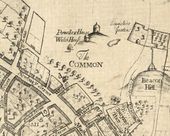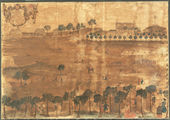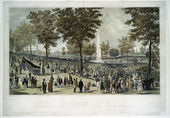Difference between revisions of "Boston Common"
[http://www.nga.gov/content/ngaweb/research/casva/research-projects.html A Project of the National Gallery of Art, Center for Advanced Study in the Visual Arts ]
(→Images) |
(→Images) |
||
| Line 88: | Line 88: | ||
File:0481.jpg|William Burgis, ''Plan of Boston in New England'', 1728. | File:0481.jpg|William Burgis, ''Plan of Boston in New England'', 1728. | ||
| − | File:0481_detail|William Burgis, ''Plan of Boston in New England'' [detail], 1728. | + | File:0481_detail.jpg|William Burgis, ''Plan of Boston in New England'' [detail], 1728. |
File:0480.jpg|Francis Dewing after John Bonner, ''A New Plan of ye Great Town of Boston in New England in America'', 1743. | File:0480.jpg|Francis Dewing after John Bonner, ''A New Plan of ye Great Town of Boston in New England in America'', 1743. | ||
Revision as of 13:43, April 18, 2018
Overview
Alternate Names:
Site Dates:
Site Owner(s):
Associated People:
Location: Boston, MA
History
Texts
- Anonymous, 1640 and 1646, describing Boston Common, Boston, MA (quoted in Adams 1842: 7)[1]
- “[March 1660] Hereafter there shall be no land granted either for house plot or garden to any person, out of the open ground or common field, which is left between the Sentry Hill and Mr. Colburn’s end. . . .
- “[May 1646] No dry cattle, young cattle, or horse, shall be free to go on the Common this year but one horse of Elder Oliver.”
- Josselyn, John, 1674, describing Boston, MA (quoted in Reps 1965: 141)[2]
- “On the South there is a small but pleasant common, where the Gallants a little before Sunset walk with their Marmalet-Madams.”
- Anonymous, May 19, 1766, Boston Evening-Post (quoted in Brigham 1954: 21)[3]
- “ . . . [T]he Gentlemen Selectmen of Boston, have fix’d upon this Evening for the public Rejoicing, at whose Desire, will be exhibited on the Common, an OBELISK.—A Description of which is engraved by Mr. Paul Revere; and is now selling by Edes & Gill.—The Signal of its Ending will be by firing a Horizontal Wheel on the Top of the Obelisk, when its desired the Assembly would retire.”
- “On the south west side of the town, there is a pleasant promenade, called the Mall, adjoining to Boston Common, consisting of a long walk shaded by trees, about half the length of the Mall in St. James’s Park. At one end you have a fine view of the sea. The Common itself is a pleasant green field, with a gradual ascent from the sea shore, till it ends in Beacon Hill, a high point of land, commanding a very fine view of the country.”
- Anonymous, December 6, 1835, describing the Boston Common, Boston, MA (Horticultural Register 2: 33)[5]
- “Apart from the beautiful scenery connected with these resorts [public walks in New York], or in themselves alone, they cannot compare with our fine Common, of which Bostonians deservedly pride themselves, and which at a little expense might be made one of the most splendid places of promenade in the country.”
- Adams, Nehemiah, 1838, describing the picturesque quality of Boston Common, Boston, MA (Adams 1838: 40)[6]
- “Had its principles been regarded, we should have seen trees of various foliage, here standing alone, and there intermingled in copses and groves—arranged, indeed, so as to imitate nature herself, in her picturesqueness as well as her beauty.”
- Buckingham, James Silk, 1841, describing Boston Common, Boston, MA (1841: 2:331)[7]
- “This Common, as it is called, or ‘The Park,’ as it might with propriety be designated, with the fine view of the surrounding country from its more elevated parts, and the noble trees and gravel-walks throughout, is only inferior in size and beauty to Hyde Park, Regent’s Park, and the Green Park in London; and is greatly superior to any similar enclosure in New-York, Philadelphia, or Baltimore. It covers an area of seventy-five acres, and has upward of 600 trees planted in it. The whole is enclosed with an ornamental iron fence or railing, which cost 90,000 dollars, or nearly £20,000. Within it is a fine sheet of water, surrounded with elms, called ‘The Crescent Pond’; and very near the centre of the whole are the remains or traces of a fortification, thrown up by the British troops who were stationed here in 1775.
- “The Common is surrounded on three of its sides by noble rows or terraces of houses, like the parks in London; and as it was originally granted for the public use, and any farther encroachment upon it rendered impossible by a clause in the last charter of the city, it is of the utmost value to the inhabitants. It is not merely a beautifully ornamental appendage to their noble city, but is used as a place of healthful and innocent recreation for all classes, as a spot of constant exercise and promenade; and it is impossible to witness its advantages without regretting that every town in England is not provided with a similar extent of public grounds for the delight and enjoyment of its population.”
- Adams, Nehemiah, 1842, describing Boston Common, Boston, MA (Adams 1842: 9, 11–12, 22, 28, 35, 51)[8]
- “Many, very many, in a great city, seldom see the arch of heaven. Even those who walk or ride for pleasure are often struck with the effect of a full view of the sky when they are out of the city. One of the great advantages of the Common is the unobstructed sight of the heavens above it. . . .
- “Indeed it is seldom that a piece of ground is seen which, with no greater extent, is so diversified in surface and combines so much in itself that is picturesque, as the Common. There is hill and plain, meadow and upland, in it. It has sufficient irregularity to make a pleasing variety of surface without being rough; its elevations are well sloped towards the plain part of the enclosure; indeed it would be difficult for art to arrange the surface of the Common more agreeable for pleasing effect or use. . . .
- “The Common with its malls for hoops, and ball, and marbles, and wicker carriages, its Frog Pond for boats and skating, its hills for coasting, its new cut grass, its training days and military parades, and fireworks, the governor taking his chair at ‘artillery election,’ and all its varied entertainments, contributes as largely as any place can do to the formation of those youthful impressions which make childhood happy, and the remembrances of it pleasant. . . .
- “The Common with its varied surface is admirably fitted for military exhibitions. . . .
- “One of the most interesting exhibitions that ever took place on the Common was that of the Indians of the Sacs and Fox, the Sioux and Iowa tribes, who visited us in the fall of 1837. They held a war dance on the Common in the presence of seventy thousand spectators. . . .
- “The centre of the Common is obstructed by rows of young but thrifty and fast increasing trees. They were planted along the principal paths, for the benevolent purpose of affording shade to those who cross the Common. Their usefulness even in this respect is doubtful, and there is more than a doubt respecting their good influence upon the Common as a public ground. Our summers are so short, the air of the Common is generally so cool or in such good circulation, that the use of shaded walks through its centre is very small compared with the desirableness of having one large open place, as the Common has always been, in a crowded city. We do not need the whole Common as a mere parasol; its wide and free grounds and prospect are its chief beauty, and the shaded malls are sufficient as places of resort from the heat. . . . There will soon be an end to great public exhibitions on the Common, if the trees now in the centre should thrive.”
- Tuthill, Louisa C., 1848, describing Boston Common, Boston, MA (1848; repr., 1988: 318)[9]
- “The Boston Common is the most spacious public pleasure-ground in the United States. Seventy-five acres were appropriated by the early ‘fathers of the town’ to this purpose, on the condition that it should ever remain devoted in this way to public convenience and comfort. The same venerable elms which shaded the patriots of the Revolution, still wave over the heads of their successors, and fresh young trees are planted from year to year by the side of the new-gravelled walks, rendered necessary by the rapidly increasing population of the city. The undulating ground of the Common gives it a pleasing diversity of hill and vale, and the little lake or pond near the centre, adds to its picturesque beauty.”
- Loudon, J. C., 1850, describing Boston Common, Boston, MA (1850: 332–33)[10]
- “856. Public Gardens. . . .
- “At Boston there are extensive public pleasure-grounds called the Common, consisting of seventy-five acres, in the very heart of the city. This piece of ground is well laid out, and contains many fine trees. The state-house, and the handsome houses of the city, surround it on three sides.”
- Jaques, George, February 1851, describing the planting of trees in Boston Common, Boston, MA (Magazine of Horticulture 17: 50–52)[11]
- “I propose, at present, to speak first of planting trees upon side-walks. In American cities, it is customary to construct streets with a wide carriageway in the middle, and a walk for pedestrians on either side. Trees are usually planted on the line between these foot-walks and the carriageway. . . .
- “Take as an example Boston Common. Here we have, for the most part, a smooth grass surface, intersected by straight wide gravel-walks, and these lined on each side with trees placed along at equal distances from each other. But suppose no tree or walk were there, and a carte blanche were given to any one that he might arrange all things to his own fancy, what would you do, Mr. Editor? Would you plant straight rows of equidistant trees there? Probably not. For, although such an arrangement of fruit or shade trees may be in its place very convenient and useful, it can never please the eye which admires the picturesque beauty of trees growing in groups.”
Images
Benjamin Franklin Smith Jr., View of the Water Celebration, on Boston Common October 25th 1848, 1849.
Map
Other Resources
https://www.boston.gov/parks/boston-common
http://www.thefreedomtrail.org/freedom-trail/boston-common.shtml
http://friendsofthepublicgarden.org/our-parks/the-common/
https://www.nps.gov/nr/travel/massachusetts_conservation/boston_common.html
Notes
- ↑ Nehemiah Adams, Boston Common (Boston: William D. Ticknor and H. B. Williams, 1842), view on Zotero.
- ↑ John W. Reps, The Making of Urban America: A History of City Planning in the United States (Princeton, NJ: Princeton University Press, 1965), view on Zotero.
- ↑ Clarence Brigham, Paul Revere’s Engravings (Worcester, MA: American Antiquarian Society, 1954), view on Zotero.
- ↑ Henry Wansey, Henry Wansey and His American Journal, ed. David John Jeremy (1794; repr., Philadelphia: American Philosophical Society, 1970), view on Zotero.
- ↑ Anonymous, “Leaves from my Note Book,” The Horticultural Register and Gardener’s Magazine 2 (January 1, 1836), view on Zotero.
- ↑ Nehemiah Adams, The Boston Common, or, Rural Walks in Cities (Boston: G. W. Light, 1838), view on Zotero.
- ↑ James Silk Buckingham, America, Historical, Statistic, and Descriptive, 2 vols. (New York: Harper, 1841), view on Zotero.
- ↑ Nehemiah Adams, Boston Common (Boston: William D. Ticknor and H. B. Williams, 1842), view on Zotero.
- ↑ Louisa C. Tuthill, History of Architecture, from the Earliest Times; Its Present Condition in Europe and the United States; with a Biography of Eminent Architects, and a Glossary of Architectural Terms, by Mrs. L. C. Tuthill (1848; repr., Philadelphia: Lindsay and Blakiston, 1988), view on Zotero.
- ↑ J. C. Loudon, An Encyclopeaedia of Gardening; Comprising the Theory and Practice of Horticulture, Floriculture, and Arboriculture, and Landscape-Gardening, new ed. (London: Longman et al., 1850), view on Zotero.
- ↑ George Jaques, “Trees in Cities,” Magazine of Horticulture 17 (February 1851), view on Zotero.








